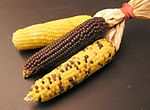Mielie meal
This article needs additional citations for verification. (October 2017) |
 Mielie Meal paste served with syrup as a breakfast dish | |
| Alternative names | Maize meal/ Bota |
|---|---|
| Type | Flour; staple food |
| Course | Any, often breakfast |
| Place of origin | Southern Africa |
| Main ingredients | Maize |
| Similar dishes | Cornmeal |
Mielie meal, also known as mealie meal or maize meal, is a relatively coarse flour (much coarser than cornflour or cornstarch) made from maize[1] or mealies in Southern Africa, from the Portuguese milho. It is also known by various other indigenous language names depending on the locality or country. It was originally brought to Africa from the Americas by the Portuguese.[2]
It is a food that was originally eaten by the Voortrekkers during The Great Trek[citation needed], but has become the staple diet of South Africa, because of its ability to be stored without refrigeration, it is cheap and abundant in all shops and markets. It is a staple food in South Africa,[3] Mozambique, Lesotho, Eswatini, Zambia, Zimbabwe, Malawi, Botswana and many other parts of Southern Africa, traditionally made into uphuthu, sour-milk porridge, pap, and also umqombothi (a type of beer).
Pap and phutu[]
The raw ingredient of mielie meal is added to boiling water, the ratio of which produces either porridge[3] or the firmer pap/nshima/sadza. When making porridge, milk it is sometimes used to produce a creamier dish, the porridge usually has a thick texture and is commonly eaten for breakfast in southern Africa.[citation needed] The firmer pap is eaten with meat and gravy dishes as well as vegetable relishes. It is similar to Italian polenta except that it, like grits in the Southern United States, is usually made of a white rather than a yellow maize variety.
Nutrition facts[]
Mealie meal is a very high energy food, containing carbohydrates, protein, fat and fiber.[4]
See also[]
- Cornmeal
- Grits
- Samp
- Sadza
- List of maize dishes
References[]
- ^ Sellick, W. (2010). The Imperial African Cookery Book: Recipes from English-speaking Africa. Jeppestown Press. p. 330. ISBN 978-0-9553936-8-6.
- ^ "Welcome to Amaize". www.amaize.co.za. Retrieved 22 April 2021.
- ^ Jump up to: a b Mwakikagile, G. (2008). South Africa and Its People. New Africa Press. p. 186. ISBN 978-0-9814258-3-2.
- ^ "Calories in Ace Mealie Meal and Nutrition Facts". www.fatsecret.co.za. Retrieved 30 May 2020.
- South African cuisine
- Staple foods
- Maize products
- Flour
